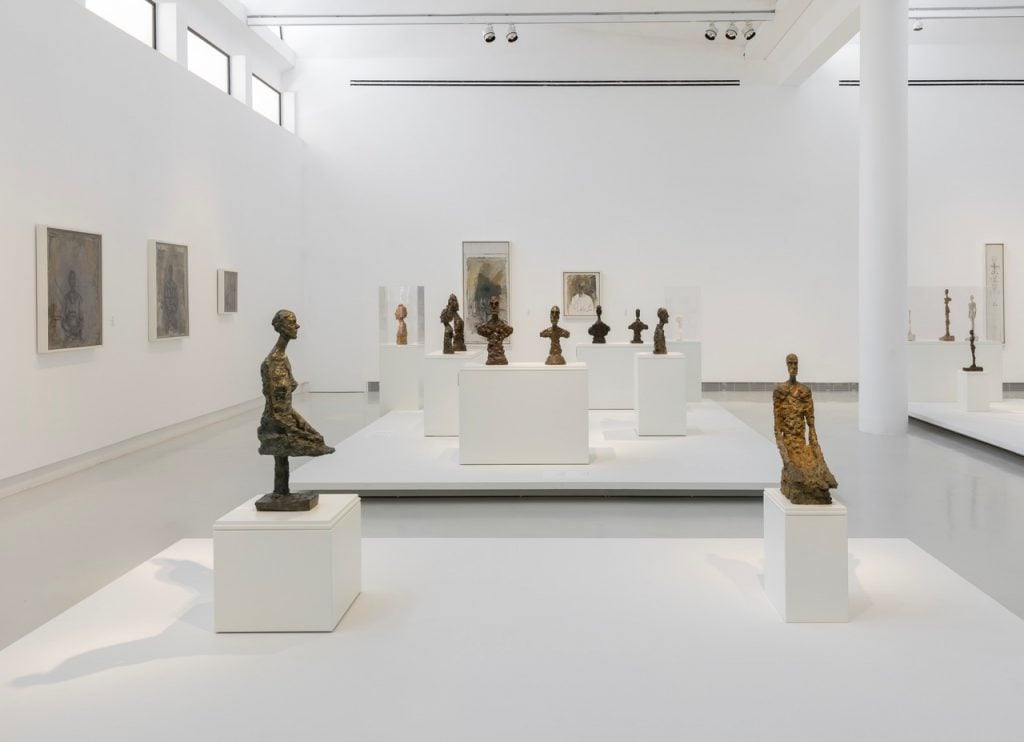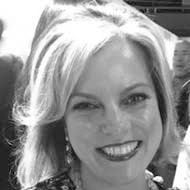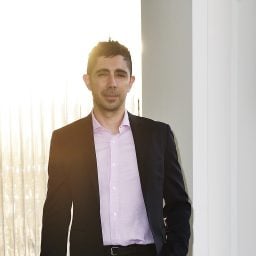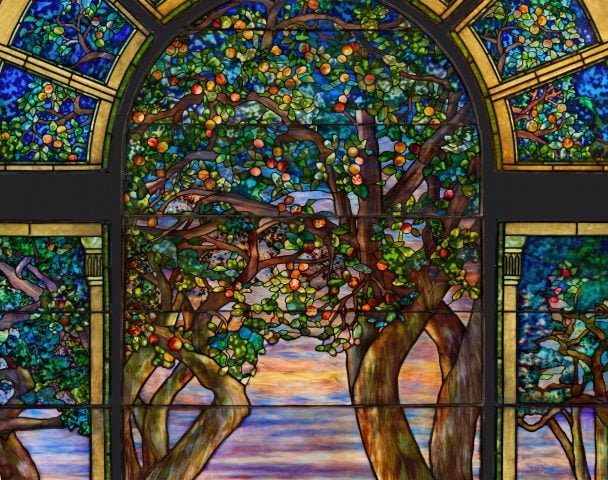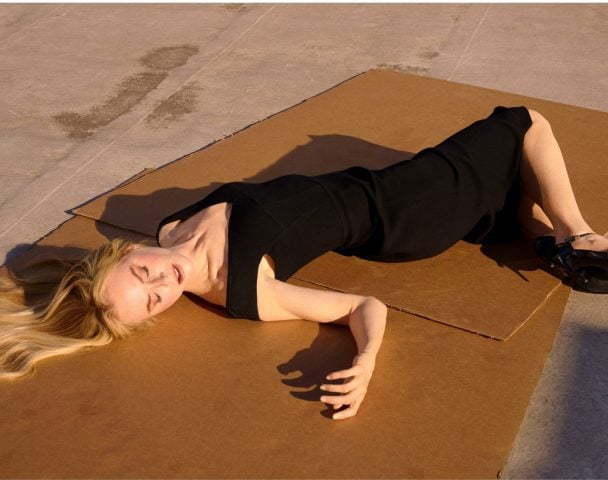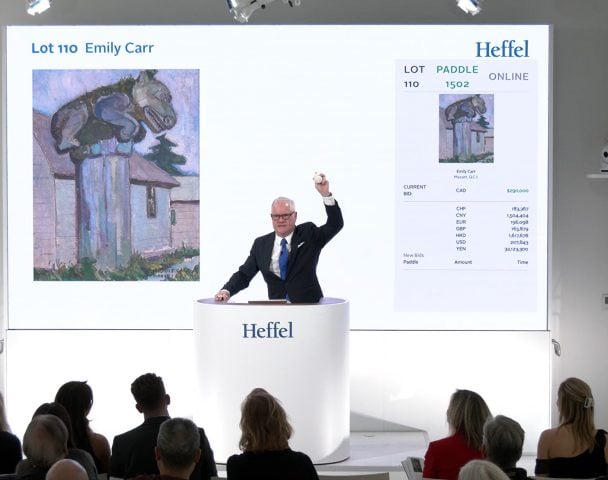On the morning of October 7, Tania Coen-Uzzielli, director of the Tel Aviv Museum of Art, was on her way back to Israel from a conference in Florence. While waiting for a connecting flight in Rome, she got a call from the museum’s head of exhibitions: There are rockets flying over Tel Aviv.
That by itself was not entirely uncommon. But the news made Coen-Uzzielli gravely concerned.
That’s because October 7 was supposed to be the final day of “Beginning, Again,” the first retrospective of Alberto Giacometti in Israel. It featured 130 works, the majority of which was loaned by Fondation Giacometti in Paris, which co-organized the landmark exhibition along with the Tel Aviv Museum of Art and the Israel Museum in Jerusalem.
Insured for $400 million, the show featured significant plasters, bronzes, paintings, drawings, and prints. Highlights included iconic works such as Walking Woman (1932), Point to the Eye (1931–32), Bust of Silvio (1945), Three Walking Men (1948), The Cage (1950), and an ensemble of Woman of Venice (1956).
The exhibition opened in May in a newly refurbished modernist building long known as the Helena Rubinstein Pavilion, recently renamed after billionaire Eyal Ofer following a $5 million gift from the Eyal and Marilyn Ofer Family Foundation. About 2,500 people bought tickets to see the haunting works on the last day of the exhibition. They never got a chance.
Coen-Uzzielli instructed her staff to start taking down the show immediately and placing the objects in a safe space inside the museum. She was going to make calls to the foundation to get the green light.
“Do I need to send a courier?” the foundation’s director, Catherine Grenier, asked Coen-Uzzielli. “Please don’t,” the museum director replied.
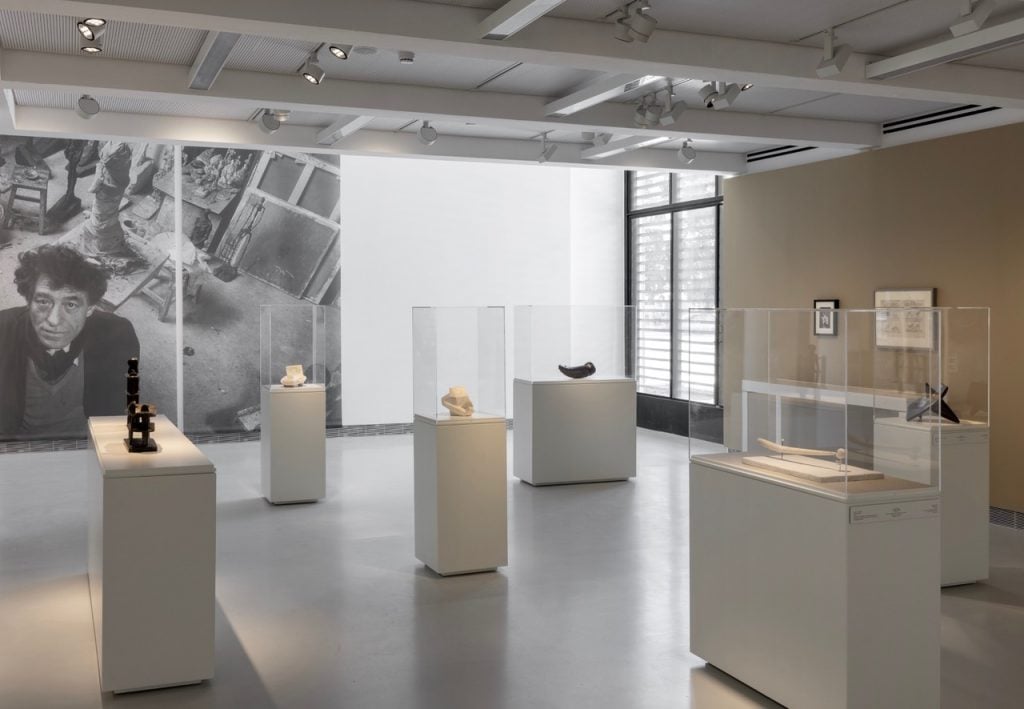
Installation view of “Alberto Giacometti: Beginning, Again” at the Tel Aviv Museum of Art. Photo: Elad Sarig.
Three and a half hours later, when Coen-Uzzielli landed in Tel Aviv, her country was at war. But every single Giacometti artwork had been put away safely in storage.
During the ensuing few days, even as the museum had to close and pivot online in a move eerily reminiscent of COVID-19 shutdowns, the staff hurried to prepare the works for shipment back to France. In accordance with its procedures, the 71 works from the foundation, including the original (and fragile) plaster molds, were split up into two shipments.
“They came like this, it’s a regular museum practice,” Coen-Uzzielli said. “It’s like the royal family that’s not flying all together.”
The first El Al cargo left on October 13 and the second on October 16, according to Soizic Wattinne, deputy director at the Fondation Giacometti.
Both flew to Liège, Belgium, not Paris. That was the fastest way to get out of the war zone, she added. After landing there, the works were trucked to Paris, arriving safely and undamaged.
“Tel Aviv Museum was a wonderful partner,” said Wattinne, “very professional and committed to protecting the works.”
The Tel Aviv Museum wasn’t the only institution that ended up in the crosshairs of the war. Lines of support were being drawn in the sand all through the week as more and more people chose a side—and screamed as loud as they could. Just yesterday, 8,000 artists published an open letter in Artforum voicing their support for the Palestinians, but conspicuously not saying a word about the largest Jewish massacre since the Holocaust (more on that later).
The semi-annual celebrations surrounding big museum openings in Doha were canceled last-minute “due to the increase in volatility in the region,” the organizers said.
Qatar’s royal family has spent billions on art in the past two decades.
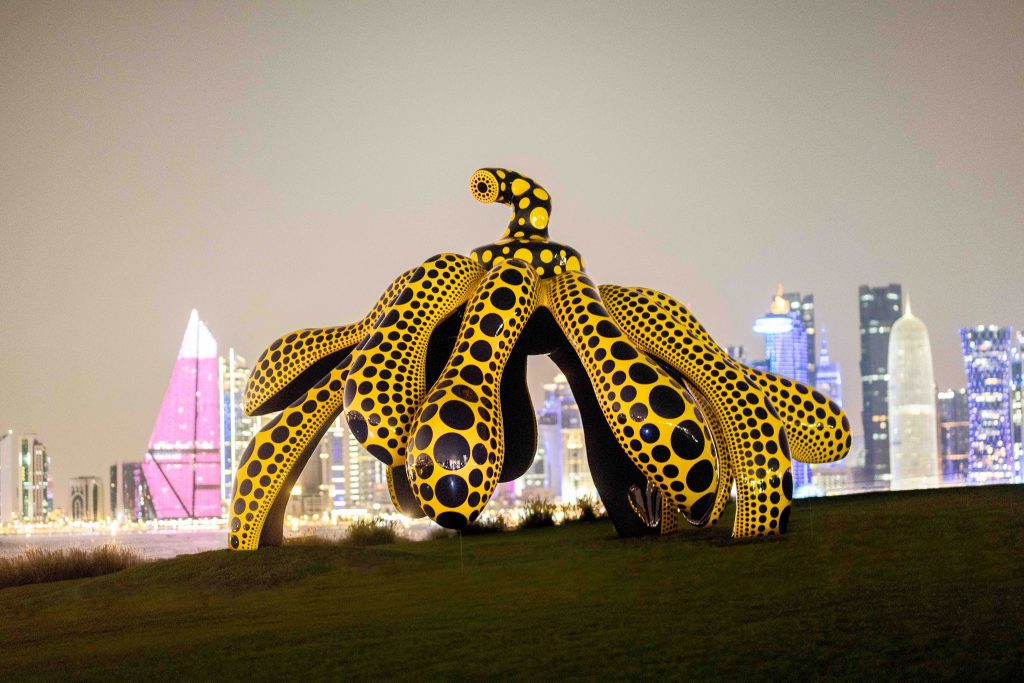
Yayoi Kusama, Dancing Pumpkin, 2020. Installation view, “My Soul Blooms Forever,” Museum of Islamic Art, Doha, Qatar, November 19, 2022–March 1 2023. Photo courtesy of Qatar Museums. Artwork © YAYOI KUSAMA. Courtesy of David Zwirner, Ota Fine Arts, and Victoria Miro.
The exhibitions, which are still set to open next week, include “Dan Flavin | Donald Judd: Doha” at QM Gallery Al Riwaq, co-organized by the Los Angeles County Museum of Art and co-curated by the museum’s director, Michael Govan.
There is also the display of 130 works from the Metropolitan Museum of Art’s Oceanic collection, traveling outside of the Met for the first time in almost a century while the museum’s Michael C. Rockefeller Wing is being renovated.
Last week, shortly after Hamas fighters massacred 1,400 Israelis, including babies, women, and the elderly, and took hostages, the chairperson of Qatar Museums, Sheikha al Mayassa, posted images of the Palestinian flag projected onto the museum facades on her social media accounts.
Max Hollein, the Met’s director, was planning to go to Doha, but canceled the trip after the celebration was nixed—and so did LACMA’s Govan, the museums confirmed. Whether the usual contingent of other art luminaries will go to Doha is unclear.
While many museums remain mum on the topic of Israel and Gaza, the rift in the art world is growing between pro- and anti-Israel contingencies. Sometimes it is happening within the same institution.
Take the Jewish Museum, which so far has been the only New York institution to speak up in support of Israel. Meanwhile one of its curators took to social media, reposting other groups’ denouncements of Israel’s “genocide” in Gaza and urging followers to “call on Congress” in order to “stop Gaza genocide.”

The Jewish Museum’s was the only museum in New York City to publicly voice its support for Israel. Source: Instagram.
Those posts didn’t sit well with at least one American Jewish artist, who sent a searing letter to museum leadership, viewed by the Art Detective.
“Is this what the Jewish Museum believes in and promotes?” the letter said. “Is this the kind of person you task with liaising with Jewish artists? The memory of the Holocaust is still fresh and the bodies of the 21st century’s bloodiest pogrom against the Jews have yet to be buried. I am outraged. We all know there are many voices within the Jewish community, but there has to be a line of decency.”
A representative for the Jewish Museum said that it is aware of the incident, but did not respond to questions about its social media policy for employees.
“This distressing post does not reflect the point of view of the Museum, nor does it represent its values,” the spokeswoman said in an emailed statement. “The use of this language is inaccurate, deeply troubling, and painful for so many people, and especially for members of the Jewish community and for all of those affected by the attacks on October 7 and thereafter. The Jewish Museum’s mission is to share ideas, promote dialogue, and foster understanding of Jewish culture and experience, and the museum will be working with its staff to ensure that the history and perspectives surrounding this conflict are discussed and understood.”
The Jewish Museum curator isn’t alone. The open letter in Artforumwas signed by prominent artists Nan Goldin, Peter Doig, Kara Walker, Nicole Eisenman, Barbara Kruger, and Martha Rosler, some of whom are Jewish.
“We demand that the institutional silence around the ongoing humanitarian crisis that 2.3 million Palestinians are facing in the occupied and besieged Gaza Strip be broken immediately,” the letter said. It made no mention of the atrocities by Hamas against Israeli civilians that started the war.
When reached by phone, Goldin, who is Jewish, said she didn’t write the letter. “Yes, it should have mentioned loss on both sides,” she said. She also signed a more nuanced letter to U.S. President Joseph Biden by Jewish writers, artists, and other members of the intelligentsia.
Institutional silence on the matter notwithstanding, the specter of the hostages—whose grim fate is terrifying to contemplate—was brought to museums’ doorsteps anyway.

The view of the Tate in London.
This week the names and faces of the children believed to have been kidnapped by Hamas began appearing on a monumental scale on buildings and museums. In London, the image of a 4-year-old red-haired boy named Ariel was projected on the facade of Tate Modern. In New York, projections of other children appeared on the facade of the Museum of Art and Design at Columbus Circle.
Representatives for both museums said the projections weren’t authorized.
“It happens more often than you think because of our location,” a representative for MAD told me, listing past projections by fashion brands and the Rolling Stones. “People go rogue.”
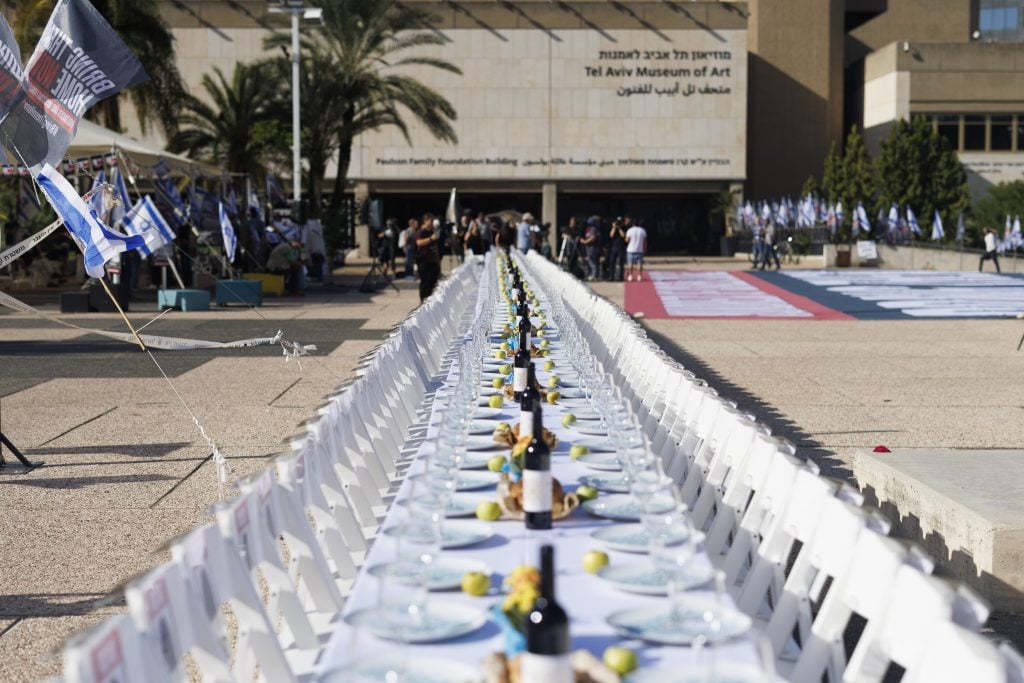
Shabbat Table installation to remember 200 hostages taken by Hamas on Oct. 7, in front of the Tel Aviv Museum of Art. Credit: Kobi Wolf
Back in Tel Aviv, the families of the hostages gathered on the plaza outside of the museum today for an event titled, “Bring Them Back Now.” The plaza was renamed to “Hostages and Missing Square.”
All around the plaza, photographs of the hostages lined makeshift stands—faces of young and old, men and women.
A large Shabbat table lined with a crisp white tablecloth was set for 200 people, an empty chair for each of those Israel says are still in captivity as hostages. Their families hugged and cried. It was a haunting gesture of absence to remind the world of the horror some want to unsee or forget.
